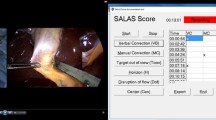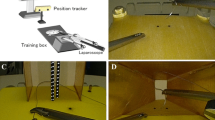Abstract
Background
Alterations of video monitor and laparoscopic camera position may create perceptual distortion of the operative field, possibly leading to decreased laparoscopic efficiency. We aimed to determine the influence of monitor/camera position on the laparoscopic performance of surgeons of varying skill levels.
Methods
Twelve experienced and 12 novice participants performed a one-handed task with their dominant hand in a modified laparoscopic trainer. Initially, the camera was fixed directly in front of the participant (0°) and the monitor location was varied between three positions, to the left of midline (120°), directly across from the participant (180°), and to the right of the midline (240°). In the second experiment monitor position was constant straight across from the participant (180°) while the camera position was adjusted between the center position (0°), to the left of midline (60°), and to the right of midline (300°). Participants completed five trials in each monitor/camera setting. The significance of the effects of skill level and combinations of camera and monitor angle were evaluated by analysis of variance (ANOVA) for repeated measures using restricted maximum likelihood estimation.
Results
Experienced surgeons completed the task significantly faster at all monitor/camera positions. The best performance in both groups was observed when the monitor and camera were located at 180° and 0°, respectively. Monitor positioning to the right of midline (240°) resulted in significantly worse performance compared to 180° for both experienced and novice surgeons. Compared to 0° (center), camera position to the left or the right resulted in significantly prolonged task times for both groups. Novice subjects also demonstrated a significantly lower ability to adjust to suboptimal camera/monitor positions.
Conclusion
Experienced subjects demonstrated superior performance under all study conditions. Optimally, the camera should be directly in front and the monitor should be directly across from a surgeon. Alternatively, the monitor/camera could be placed opposite to the surgeon’s non-dominant hand. The suboptimal camera/monitor conditions are especially difficult to overcome for inexperienced subjects. Monitor and camera positioning must be emphasized to ensure optimal laparoscopic performance.




Similar content being viewed by others
References
Holden JG, Flach JM, Donchin Y (1999) Perceptual-motor coordination in an endoscopic surgery simulation. Surg Endosc 13: 127–132
Omar AM, Wade NJ, Brown SI, Cuschieri A (2005) Assessing the benefits of “gaze-down” display location in complex tasks. Surg Endosc 19: 105–108
Emam TA, Hanna G, Cuschieri A (2002) Comparison of orthodox vs off-optical axis endoscopic manipulations: importance of monitor display angles. Surg Endosc 16: 401–405
Matern U, Faist M, Kehl K, Giebmeyer C, Buess G (2005) Monitor position in laparoscopic surgery. Surg Endosc 19: 436–440
Conrad J, Shah AH, Divino CM, Schluender S, Gurland B, Shlasko E, Szold A (2006) The role of mental rotation and memory scanning on the performance of laparoscopic skills: a study on the effect of camera rotational angle. Surg Endosc 20: 504–510
Smith WD, Berguer R, Nguyen NT (2005) Monitor height affects surgeons’ stress level and performance on minimally invasive surgery tasks. Stud Health Technol Inform 111:498–501
Zehetner J, Kaltenbacher A, Wayand W, Shamiyeh A (2006) Screen height as an ergonomic factor in laparoscopic surgery. Surg Endosc 20:139–141
Moschos E, Coleman RL (2004) Acquiring laparoscopic skill proficiency: does orientation matter. Am J Obstet Gynecol 191: 1782–1787
Hanna GB, Shimi SM, Cuschieri A (1998) Task performance in endoscopic surgery is influenced by location of the image display. Ann Surg 227:481–484
Medina M (1997) Image rotation and reversal: major obstacles in learning intracorporeal suturing and knot-tying. JSLS 1: 331–336
Breedveld P, Stassen HG, Meijer DW, Jakimowicz JJ (2000) Observation in laparoscopic surgery: overview of impeding effects and supporting aids. J Laparoendosc Adv Surg Tech A 10: 231–41
Gallagher AG, McClure N, McGuigan J, Ritchie K, Sheehy NP (1998) An ergonomic analysis of the fulcrum effect in the acquisition of endoscopic skills. Endoscopy 30: 617–620
Gallagher AG, Ritter EM, Lederman AB, McClusky DA, Smith CD (2005) Video-assisted surgery represents more than a loss of three-dimensional vision. The American Journal of Surgery 189: 76–80
Crothers I, Gallagher A, McClure N, et al. (1999) Experienced laparoscopic surgeons are automated to the “fulcrum effect”: an ergonomic demonstration. Endoscopy 31: 365–369
Emam TA, Hanna G, Cuschieri A (2002) Ergonomic principles of task alignment, visual display, and direction of execution of laparoscopic bowel suturing. Surg Endosc 16: 267–271
Zheng B, Janmohamed Z, MacKenzie CL (2003) Reactio times and the decision-making process in endoscopic surgery: an experimental study. Surg Endosc 17: 1475–1480
Author information
Authors and Affiliations
Corresponding author
Rights and permissions
About this article
Cite this article
Haveran, L.A., Novitsky, Y.W., Czerniach, D.R. et al. Optimizing laparoscopic task efficiency: the role of camera and monitor positions. Surg Endosc 21, 980–984 (2007). https://doi.org/10.1007/s00464-007-9360-3
Received:
Revised:
Accepted:
Published:
Issue Date:
DOI: https://doi.org/10.1007/s00464-007-9360-3




